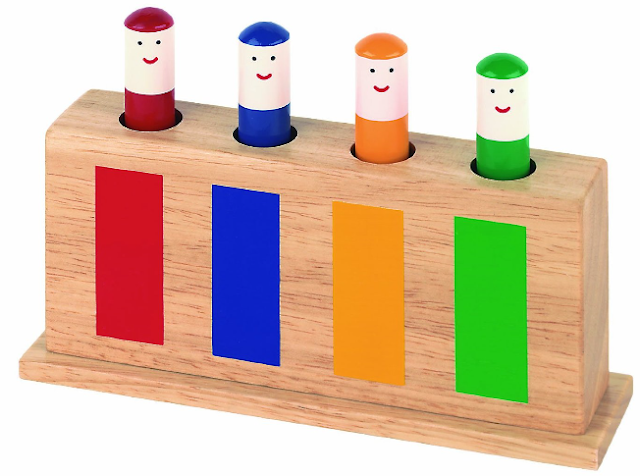I like using games with launchers with kids that need frequent reminders to use a stabilizing hand. It emphasizes the necessity of using both hands in a coordinated manner, and you can practice it over and over in a short period of time. You also need to use finger isolation with graded pressure while aiming for a target. Lots of good stuff. Another launcher game I like is Connect 4 Launchers.
Hats Off! has been popular with kids across a range of abilities. The game comes with a plastic grid/base that is full of holes. It is divided into four colors that match the four hat colors. Each color on the grid has nine holes. Each hat has a small metal ball in the tip that adds weight.
To play, place the grid in the middle of the players. Each player chooses a color and gathers that color launcher and six matching hats. On go, each player loads his launcher by placing one hat on the lever and fires. Everyone launches at the same time, trying to land their colored hats into the same colored section on the grid. Once someone gets all six hats into his colored holes, he yells "Hats Off" and the round ends. Individuals add their scores, depending on where their hats have landed. A game can consist of several rounds with the highest scorer winning.
Try this:
- Play alone. Start by trying to just land anywhere on the grid. Then move to aiming for color.
- Demonstrate to show how far the hat will travel if you push the lever all the way down as opposed to pushing it only part way.
- Ask the player to determine if he pushed the lever down too far or not far enough after missed efforts. Then adjust and try again.
- Practice grading different amounts of pressure by pushing the grid away or pulling it closer to the player.
- Place the hats in the grid by color for a simple matching activity.
- Play alone and try to land each piece in it's own color section. After launching them all, add one point for each one in it's matching color. Remove the pieces and play again, trying to better your aim, get more matches and up your score.
- Work on visual discrimination, eye-hand coordination, manual dexterity, graded pressure, fine motor precision, finger isolation, aiming at a target, coordinated use of both hands, social skills, play and leisure exploration and participation







